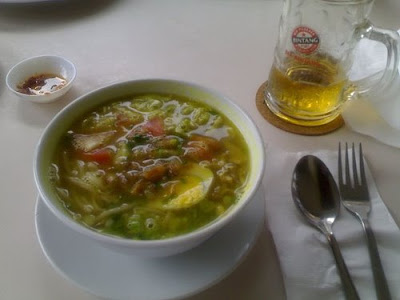Indonesian Soups
Indonesian soups can be divided into two categories: sops and sotos. A sop is similar to a Western soup with a clear broth and some ordinary looking vegetables. Soto venture into much less familiar waters to include chilies, sour galingale, lemon grass, and sometimes coconut milk. While a sop might provide comfort on a cold winter's day, sotos are more the ticket for a hot one. Between the actual temperature of the soto and the chilies it contains, you might break into a sweat powerful enough to make even a puny breeze feel downright cool. Sotos are also open to improvisation by the server. Where a sop will be ladled straight away from a single stock pot, sotos tend to be assembled from their components on the spot.
First cooked noodles are added to an empty bowl and covered with a broth from one pot and some meat from another. Some of Indonesian soups cooked with vegetables. Various vegetables are added and allowed to steam in the bowl while splashes from different bumbus cover them. Finally an assortment of garnishes tops things off.
Soups and Salads (Sop, Soto, dan Sayur Segar)
Like soto, bakso is prepred and served "on demand" and relies on synergy to create the perfect flavor for the moment. Bakso (also called baso) pushcarts are everywhere with great variations in the shape, size, and source of the meatballs, tofu, noodles, and leafy vegetables used. Bubur is also popular, especially for breakfast and late at night. It is typically covered with so many bumbus and condiments that it's easy to forget it's just rice porridge.
Perhaps the most well known Indonesian salad is gado-gado, but many other varietes abound with bumbu dressings that explore the realm between sweet, sour, and hot. The bumbu is usually ground before your eyes but at home you might want to prepare enough to last a few weeks.
The combination of palm sugar, tamarind and chili peppers is one of the secrets to dealing with a sweltering day. Perhaps that's why vendors for asinan and rujak hit the streets during the hottest period and exploit this tongue-warping effect. You will no-doubt sweat off any excess calories the snack provides.
Bookmark/share this article with others:First cooked noodles are added to an empty bowl and covered with a broth from one pot and some meat from another. Some of Indonesian soups cooked with vegetables. Various vegetables are added and allowed to steam in the bowl while splashes from different bumbus cover them. Finally an assortment of garnishes tops things off.
Soups and Salads (Sop, Soto, dan Sayur Segar)
Like soto, bakso is prepred and served "on demand" and relies on synergy to create the perfect flavor for the moment. Bakso (also called baso) pushcarts are everywhere with great variations in the shape, size, and source of the meatballs, tofu, noodles, and leafy vegetables used. Bubur is also popular, especially for breakfast and late at night. It is typically covered with so many bumbus and condiments that it's easy to forget it's just rice porridge.
Perhaps the most well known Indonesian salad is gado-gado, but many other varietes abound with bumbu dressings that explore the realm between sweet, sour, and hot. The bumbu is usually ground before your eyes but at home you might want to prepare enough to last a few weeks.
The combination of palm sugar, tamarind and chili peppers is one of the secrets to dealing with a sweltering day. Perhaps that's why vendors for asinan and rujak hit the streets during the hottest period and exploit this tongue-warping effect. You will no-doubt sweat off any excess calories the snack provides.


0 comments:
Post a Comment